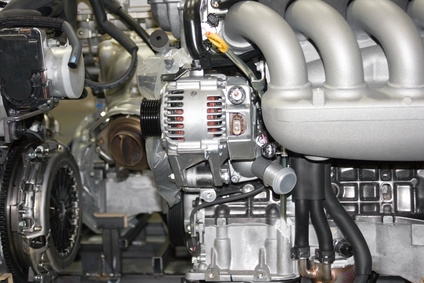
Denso alternators are fitted to top production cars worldwide and are used in motor sports, according to Denso. They are lightweight but durable and are available with outputs of 40 to more 160 amperes, depending on the vehicle's electrical consumption. Most Denso alternators fitted to production cars produce between 50 and 75 amperes, enough to power the increasing number of electrical devices fitted to modern cars. To check that your Denso alternator's output matches the manufacturer's labeled output, use a multimeter.
Read the Denso alternator output specifications in your car's manual. Specifications are usually at the back of the manual. Two ampere ratings are given: minimum and maximum output. Minimum refers to low electrical usage while maximum refers to high energy usage such as when you have lights, heater and windshield wipers on. Output varies by alternator but is likely to show a ratio of something like 50:100, meaning 50 amperes minimum and 100 amperes maximum. Write the numbers down.
Put on a pair of safety goggles and rubber gloves. Denso alternators produce substantial energy, so you need to protect yourself from electric shock or a spark in your eye. Make sure you don't have loose clothing because you will need to start the engine.
Open the car's hood. Start your car engine. Let it idle until it reaches normal operating temperature.
Set the multimeter to read amperes. Set the range on the multimeter to 20 percent below the minimum figure and 20 percent above the maximum. For example, if the ratio for your Denso alternator is 50:100, set the multimeter to read between 40 and 120 amperes.
Place the negative prong at the end of the wire from your multimeter onto the negative terminal of your car battery. The negative prong at the end of the black wire and the negative battery terminal are labeled "-".
Place the positive prong on the end of the red wire from the multimeter onto the positive terminal of your battery. The positive terminal is labeled "+". Expect it to create a spark as it touches. This is normal. You can reduce, or avoid, the spark by placing the prong quickly and firmly onto the terminal.
Read the display on the multimeter. Remove the prongs from the battery terminals and write down the reading. The figure should be similar to, or the same as, the minimum output you wrote down earlier. If you wrote down 50 amperes, a Denso alternator in good condition should produce between 45 and 55 amperes. If it's much less than 45, have it checked by a professional.
Ask an adult helper to sit in your car and turn on all the electrical equipment, including all lights, heater-fan and windshield wipers. You need the car to use as much energy as possible so your alternator has to compensate. The car engine speed will drop as the electrical equipment is turned on.
Get the helper to increase the engine speed to 2,500 rpm. Place the negative prong from your multimeter on the negative battery terminal. Place the positive prong on the positive terminal of your battery. Expect a larger spark than before.
Read the output on the multimeter. Remove the prongs and write down the reading. The reading should be much higher, in the range of 75 to 85 amperes, depending on the alternator type. If the maximum output in the manual is 100 amperes, a reading between 75 and 90 is good. If it's less than 75 amperes, check to be sure all the electrical equipment is on. If it is, have the Denso alternator professionally checked.
Turn off the electrical equipment in your car. Turn off the engine, and close the car's hood.